We had four fantastic sea days after Salalah. Here we are travelling from Salalah and heading into pirate territory off the coast of Somalia. We had been taken through a "pirate" drill earlier in the cruise. On one of the upper decks they have a dummy up against the railing. I think he is supposed to look like someone on continual watch. Even from the walking track it looks funny, so I don’t know if it would fool any pirates!
The next day we were considered safe as we left Somalia behind and went through Bab-el-Mandeb, a narrow strait between Yemen and Ethiopia. It means Gate of Grief in Arabic.
And the next day…into the Red Sea between Saudi Arabia and Sudan. You can see Mecca on the map, the most holy place of the Islam religion. All Muslims hope to make a pilgrimage to Mecca during their lifetime, and they always pray facing in the direction of Mecca.
We’re moving along…
This is at night and the sea temperature is warmer than the air.
The sun was up, but the skies remained cloudy and the seas were quite choppy. I enjoyed it as we had had such calm seas you could almost forget you were sailing.
We sailed past Egypt on our way to Jordan.
We would be docking at Aqaba, Jordan and then travelling north towards Petra.
And here we are in the port of Aqaba. I had arranged a private tour for 14 Cruise Critic members, and I didn’t see any vehicle that looked the right size at the pier. There were plenty of big buses, mostly all going to Petra.
At 7:30 a.m. on the dot, our van, driver and tour guide showed up and we were off on our two-hour drive to Petra. Petra was built by the Nabataeans more than 2200 years ago as their capital city. After the Romans absorbed the kingdom into the Roman Empire in 106 AD, Petra continued to flourish and prosper until a large earthquake in 363 AD destroyed many of the buildings. Changes in the trade route eventually left Petra abandoned except to the Bedouins (desert dwellers). The city remained unknown to the Western world, until 1812 when a Swiss explorer disguised as an Arab scholar convinced a Bedouin guide to help him find the city.
We whizzed by some horseless carriages…
Before heading into a different landscape all together.
Very rocky and harsh…we went by these lonely goats.
A sign for Amman…it has always seemed to be such a distant land, and yet here we were.
Aqaba is a tax-free city where Jordanian citizens come to buy things such as liquor and electronics. As long as it is not for resale, it is tax free, so it makes Aqaba a popular destination. This is the customs check point leaving the city.
And then out of the rugged landscape came an apple orchard…huh!
Bedouin families were recently moved into housing developments to get them out of the harsh environment of the desert. Our guide, Moath (who is also a Bedouin), told us about this very friendly Bedouin who always welcomed people to his tent for a cup of tea and to chat. When they moved into the housing development, he could not adapt to the new ways, preferring his life in the desert. He was encouraged to move closer to the road where tourists would drop in and visit. Moath assured us we did not have to pay him anything, but he wanted us to see a bit of the Bedouin way of life, so we stopped in. This is the joy of a private tour!
Our guide, Moath, on the right introducing us to his friend.
A kiss from a camel!
His son set about making tea for us. Everything in a Bedouin camp is portable so that they can pack up and put everything on their camels and move. Look at the nice shiny teapot...
This is the momma of the camel that kissed me.
This is no relation...one of the Cruise Critic members took this photo and it made me laugh. I wanted to include it somewhere, so here it is...
In the background you can see the caravan of Princess buses going by as they headed to Petra. No stops at Bedouin tents for them.
Two dogs playing…
And two turtles…you get your pets where you can in the desert!
Moath explained a little to us about the Bedouin life. Their life is simple and uncomplicated. They might journey to the nearest town for food supplies every couple of weeks. They love visitors and nothing is better than a cup of coffee and tea and talking. They are not bothered by current events, computers, cell phones, not even books.
The gentleman put the head scarf on me and we had our picture taken. I love this picture!
And with that lovely stop, we were off again on our journey to Petra. You would often see Bedouins with their camels travelling in the middle of nowhere, or it seemed like the middle of nowhere to us.
We passed by this little town…
It was shaping up to be a beautiful day. Petra can be a difficult place to visit with no shade and temperatures reaching over 40 degrees Celsius. We had been warned that it is not for the faint of heart. But so far we were being blessed with a cooler day. Look at that sky...
Petra this way!
We finally stopped for a washroom break. This was our van for the day…
And this was a very nice shop. We bought a book on Petra, which I was sure would come in handy when we went on information overload and couldn't absorb anymore.
Wow! Look at this house!
This is Wadi Musa, a town close to Petra.
And then we arrived. Guess what! Souvenirs!
Indiana Jones and the Last Crusade was filmed here, so guess what! There’s a gift store!
Our guide, Moath, was fantastic. I was so relieved as organizing a private tour can be an iffy proposition. The guide can make it or break it. He had a degree in archaeology and he was one of the top students in his school. After 9/11, he came to the US for two months on a program that tried to promote better relations and understanding of the Middle East and the US for young people.
Here was the journey we were taking. The walk into Petra is a steady decline, which makes it a difficult incline on the way back out, especially as the day gets hotter and you’re more tired. Normally the tours only go part way and then walk back out the same way. Because we were a small group, Moath arranged for a local bus to meet us at the other end and drive us out a different way. We were pretty happy about that. Not only would we get to see more, but we wouldn’t have to walk the incline on the return.
There are horses and carriages which can take you as far as the entrance of Petra. Because they work on a fixed fee, they go as fast as possible to get back for the next customer. The ride can be extremely rough and scary.
Or a horse is included in the price...most people just walk.
It was a Saturday and these kids were having a great time.
And here we saw our first monuments, the Djinn blocks. Their shape indicated that they might have been symbols of the Nabataean god, Dushara, which was usually represented by a block of stone. They are believed to be some of the earliest tombs in Petra.
The cave was a place where a family would have lived. It was carved into the rock and would have included several rooms. The black sections are a result of smoke from fires.
Inscriptions above the cave would have told something about their life.
This would have been a wealthy family's burial tomb. On the upper level were four obelisks carved into the rock. The opening on that level would have been into the burial area. On the bottom is the banquet area used to celebrate the death.
They were absolutely ingenious. The tunnel on the right was probably excavated in the 1st century BC. As the Nabataeans built structures, there was a need to protect them from flash floods that were common in the area, and to protect those walking through the Siq, the long winding sandstone canyon that brought people into the city of Petra. The tunnel is 88 m long and was cut into the rock to divert water into cisterns for use in the city.
And then we started into the Siq…
The Siq is the 1.2 km gorge which you must walk through to get to the city of Petra
What the heck? Not sure what they were doing but we skirted around them.
The Nabataeans were incredible engineers. They also built these troughs all the way through the winding Siq to collect water in the city.
Remains of the Triumphal Arch leading into the city. The opening in the rock contained carvings to represent the ancient gods. The gods were worshipped by the people passing by.
What the arch would have looked like...
The Siq was amazing with a story around every corner.
Look at how close the sides of the gorge are in some spots...
Ta da! Moath has learned many ways to amuse himself while waiting for his groups to absorb everything and catch up to him. A couple of times he mentioned he was worried about our time as we needed to be back to the ship by 4:30. Everything was so fascinating to us that we were moving at a slow pace. The downside to a private tour…if you’re late, the ship won’t wait for you. If you’re on a ship’s tour, no matter how late you are, the ship won’t leave without you.
We often thought that just around that corner would be the city, but it was another corner!
The vendors weren’t too aggressive. After being in Africa and India, they were actually pretty tame. A simple “no, thank you” usually worked.
Here the colours in the rock were just stunning. My photos cannot do them justice at all.
A residence, carved into the rock, would have contained several rooms.
A special monument with the large form on the left representing Al-Uzza (the Lord of the Mountain) and the smaller form representing Dushara, the highest goddess. I've put arrows pointing to the idols because they aren't what you might be expecting. None of the idols had faces or other human forms.
What does this rock look like? A giant fish!
Until you got around to the front of it and it looked like an elephant. OK…maybe you had to use your imagination sometimes, but we could see it!
Look at the narrow canyon! It was so breathtaking we weren’t even noticing the length of the walk. It was helping a lot that the temperature was only in the low 20’s.
What was this? A light at the end of the tunnel?
More shrines dedicated to the gods...
And we’re still walking. There were benches along the way to stop and rest, not that we had time.
Another dam that was built to divert the water that would rush down from the mountains when it rained.
What’s that ahead? Is this the light at the end of the tunnel? Moath was pointing to something, pretending that this was the important thing to be looking at.
But this was really the sight to see. Holy Hannah…our first glimpse of the Treasury. The Treasury has changed little since Charles Irby and James Mangles, Commanders in the British Royal Navy, described their first sight of it in 1818. "We do not know with what to compare this scene. Perhaps there is nothing in the world that resembles it."
The jaw dropping Treasury or Al-Khazneh. The original purpose of the Treasury remains a mystery...only that it was not a treasury. One theory is that it was built as a tomb for King Aretas III during the 1st century BC.
These people knew how to build tombs! This is the most famous building in Petra. It is carved out of pinkish red rock and is truly stunning. It is 40 m high and 28 m wide. We were not able to go into the Treasury as a lower level had recently been discovered and excavations were underway.
Jim and Kim at the Treasury.
And not surprisingly, there was a gift shop and a chance to ride camels.
We were warned about negotiating a firm price, as sometimes they might get you up on the camel, and then not let you off until you gave them more money.
A tomb with the burial chamber on top and the banquet hall on the bottom. The size and height of the tomb denoted the importance of the family in the city. Another feature is the stairway on the right of the burial room at the top. This was believed to allow the soul to go up to eternity.
Look at the size of these tombs!
This guy was playing an interesting instrument...
A much needed washroom stop...
Moath inside one of the tombs. This burial room is carved out of the rock wall and contained 17 burial chambers. At the end is a fireplace used on certain occasions.
I thought the camels were so interesting. Look at their knees and how they lie down.
A panoramic view of Petra.
The Street of Facades...these were tombs for the Nabataeans who were not quite as wealthy. The tombs had high false fronts or facades.
This is the Petra Coliseum with its seats carved out of solid rock. How they did this with only simple tools is a real wonder. It was built between 8 BC – 40 AD by Aretas IV. It had 33 rows and could seat 3500 people. The Nabataeans were so anxious to have a theatre that they most likely sacrificed some tombs, which can still be seen on the back wall.
The first of the Royal Tombs called the Urn Tomb. The vaulted rooms under the platform were believed to be a church in 447 AD. The local people called the building the Court of Justice because the underground vaults were used as a prison.
Magnificent!
The tomb on the right is the Corinthian tomb and the Royal Tomb or Palace Tomb. It is called this because the architecture is similar to Roman palaces. One has to be amazed that these tombs are carved out of a solid rock face over 2000 years ago.
This little girl was selling…rocks! Everything was $1.
We had a refreshment stop…
We enjoyed the break, and a chance to sit down and try to absorb everything we were seeing.
And then it was time to move along again.
Awww….the donkeys and the kids were cute. Sometimes the kids weren’t quite so cute when they would hit the donkeys with a stick. That was pretty hard to watch.
The Winged Lions Temple was built to hold large conferences in 1 BC. It was rebuilt by the Romans after the Roman conquest in 106 AD. At this time many columns were added. Unfortunately, most of the major buildings were destroyed by earthquakes before 500 AD.
In the lower right you can see some columns. These would have been part of the Colonnaded Street, the main street in Petra.
Qsar Al-Bint...this was the great Nabataean Temple dedicated to the gods Dushara and Al-Uzza. It is over 23 m high and survived the earthquakes due to its unique construction. In the background are some of the homes that people would have lived in.
The temple with the wide street in front paved with limestone cobbles. The closest limestone is over 50 kms away.
The largest aqueduct leading to a cistern at the centre of town. Petra was built because of the availability of fresh water from springs and rainfall.
The end of the journey! It was a donkey corral where they tried to sell you a ride back, but thank heavens we didn’t have to walk it. It had taken about 3-1/2 hours.
We went into the small museum where they showed the mosaic floors that would have been in some of the homes, much like those we saw in Turkey.
The deceased and much loved King Hussein on the right was married to an American, Lisa Halaby. Initially she was not accepted, but this changed when she showed her commitment and dedication to Jordan through her work in human rights and education. In the middle is his son, the current King of Jordan, Abdullah II.
Some of the items in the museum included a sandstone winged head of Hermes, circa 1 AD.
This urn with its lions handles was found in a church.
Upper portion of Serapes statue was found near the monumental gate.
We then got on a small bus to take us back to our van. The road we took was really a trail in some parts, but we were so happy to be riding instead of walking. Look at the colour of the sky. We had a picture perfect day. Moath said the day before it was really windy and viewing Petra while fighting off a sandstorm was a challenge.
Look at the windy road. We were up quite high. The elevation of Petra is about 900 m but we were going up to around 1200 m.
We got back to our van and it was 2:30 when we finally stopped for lunch. We were so hungry I forgot to take a picture of anything, but the food was fantastic.
The sign that was in our van window.
Another larger town. We've noticed before in the Middle East that all the houses are always white or beige.
Now these Bedouins were really roughing it.
This was a much larger tent and may have been used for livestock.
We stopped at this lookout and could see Israel in the distance. The Princess buses were also here, so even though we were a bit later than we planned, we knew if we made it back to the port before they did, we were fine.
A happy group after an amazing day.
A herd of shaggy goats snacking on…practically nothing!
And a group of camels just walking down the highway...
We made it back to port 10 minutes before our sailing time. It was the most fantastic day. Of the many places we’ve been lucky to visit, Petra rates up there with the best. Tomorrow we have a 5:30 wake up call for our long tour in Egypt to the Valley of the Kings.











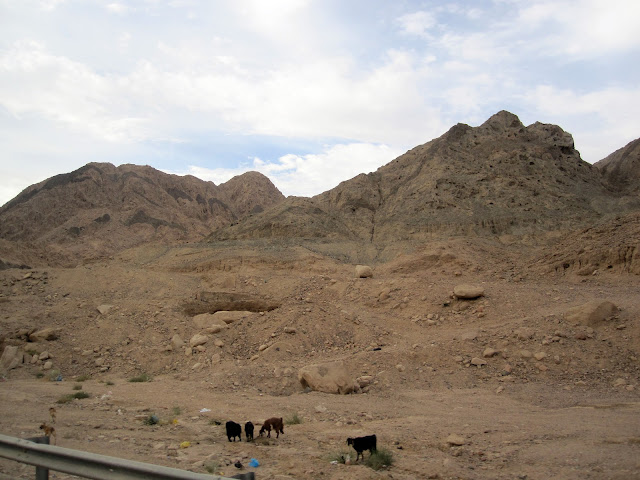


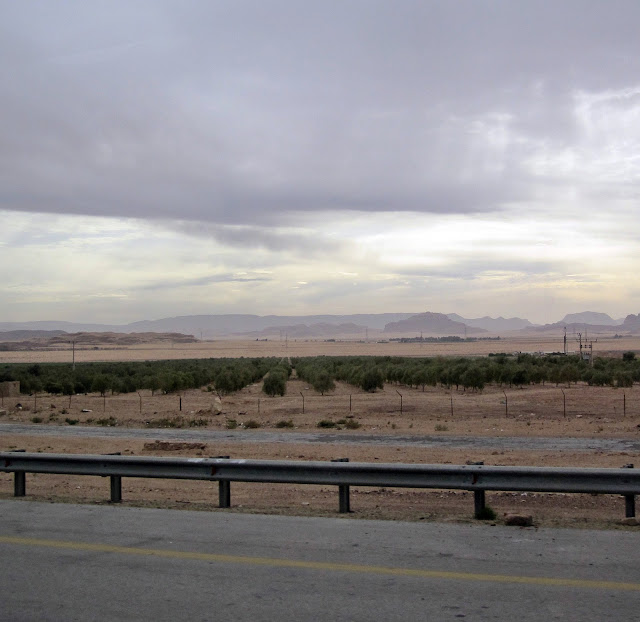















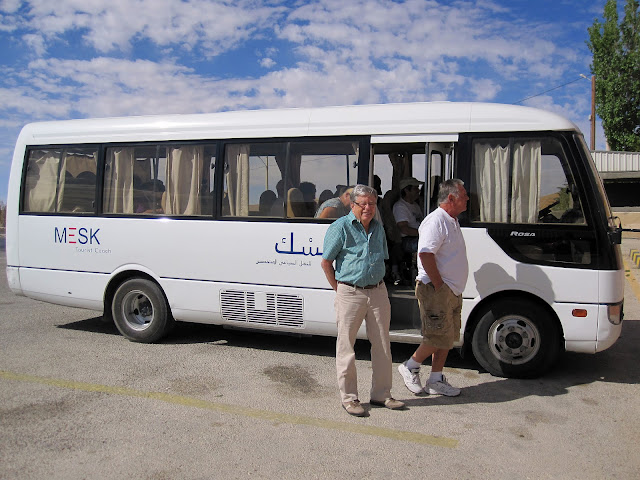








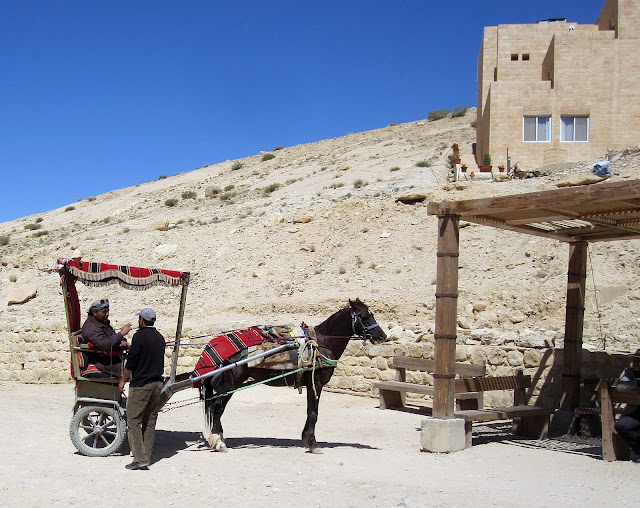










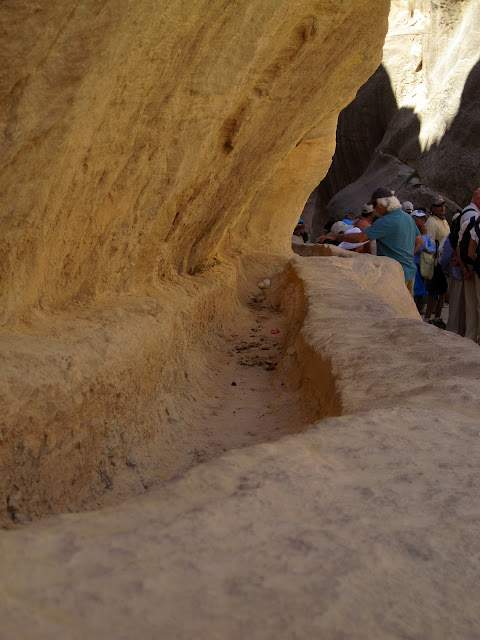






























































No comments:
Post a Comment